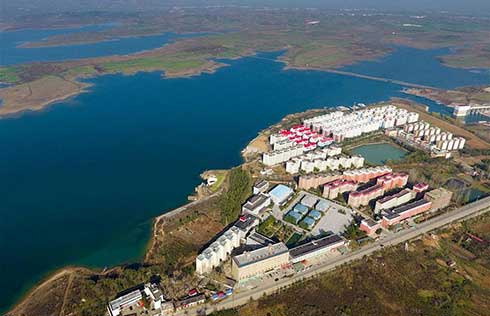Inter-city railway network to be built to upgrade Beijing-Tianjin-Hebei
BEIJING - An inter-city railway network is to be built in municipalities of Beijing, Tianjin, and Hebei by 2030, to push forward Beijing-Tianjin-Hebei integration, authorities said Monday.
According to National Development and Reform Commission (NDRC), a program to build an inter-city railway network was recently approved.
"The Beijing-Tianjin-Hebei region is going to serve as a new pole of growth for the Bohai Rim, and the safe and effective railway system shall connect the metropolitan area," said Cheng Shidong, a transport official with the NDRC.
The inter-city railway network will connect cities including Beijing, Tianjin, Shijiazhuang, Tangshan, Qinhuangdao, Langfang, and Baoding.
The Tianjin-Baoding railway, which stretches over 157 km, started running in December last year. It has shortened the commute from Tangshan to Shijiazhuang from seven hours to two-and-a-half hours.
"The Tianjin-Baoding railway can ease some of Beijing's traffic burden," said He Yongmian, chief engineer of the railway construction project.
In 2008, the Beijing-Tianjin inter-city train started running at 350 kilometers per hour and has shortened the journey between the two cities to half an hour.
Industry upgrading has also been boosted with over 850 enterprises from Beijing and Hebei establishing offices in Tianjin and over 30 billion yuan(4.36 billion US dollars) investment from enterprises in Tianjin to Hebei.
"City clusters are key to the development of a country. The United States, the U.K. and Japan, all have major city clusters which represent 60 percent of the country's GDP, but for China, the Pearl River and Yangtze River delta regions and the Beijing-Tianjin-Hebei region only contribute 38 percent to GDP," said Shao Chunfu, professor at Beijing Jiaotong University.
"Transportation infrastructure is necessary for city clusters and economic development," he added.
According to the program, commute time between major cities and their surrounding counties will be significantly reduced in the region by 2020.
A railway service will also be provided between Beijing Capital International Airport and the new airport which is now under construction.
"With people travel, also comes the flow of goods and investment," said Gao Mingming, who is in charge of the railway network plan.
"Inter-city high speed railways that cover a large area are important for Beijing-Tianjin-Hebei integration. It will help phase out non-essential functions in Beijing and promote industry distribution in the region," he added.
Railway stations will be constructed in cities or counties with a population over 100,000, according to the program.
"A better transportation system would make up for the geographical disadvantage of small cities and counties yet highlight their cheap labor and relatively low land costs," said Xiao Jincheng, a former NRDC researcher, "Cities in the metropolitan area will be closely linked to strengthen competitiveness as a whole."
"The inter-city railway network would help push the balanced development of the region," said Zhao Hong, deputy dean of Beijing Academy of Social Sciences.
China rolled out an integration plan for Beijing-Tianjin-Hebei in 2015to address urban problems such as traffic and air pollution and seek balanced development of the region.
According to National Development and Reform Commission (NDRC), a program to build an inter-city railway network was recently approved.
"The Beijing-Tianjin-Hebei region is going to serve as a new pole of growth for the Bohai Rim, and the safe and effective railway system shall connect the metropolitan area," said Cheng Shidong, a transport official with the NDRC.
The inter-city railway network will connect cities including Beijing, Tianjin, Shijiazhuang, Tangshan, Qinhuangdao, Langfang, and Baoding.
The Tianjin-Baoding railway, which stretches over 157 km, started running in December last year. It has shortened the commute from Tangshan to Shijiazhuang from seven hours to two-and-a-half hours.
"The Tianjin-Baoding railway can ease some of Beijing's traffic burden," said He Yongmian, chief engineer of the railway construction project.
In 2008, the Beijing-Tianjin inter-city train started running at 350 kilometers per hour and has shortened the journey between the two cities to half an hour.
Industry upgrading has also been boosted with over 850 enterprises from Beijing and Hebei establishing offices in Tianjin and over 30 billion yuan(4.36 billion US dollars) investment from enterprises in Tianjin to Hebei.
"City clusters are key to the development of a country. The United States, the U.K. and Japan, all have major city clusters which represent 60 percent of the country's GDP, but for China, the Pearl River and Yangtze River delta regions and the Beijing-Tianjin-Hebei region only contribute 38 percent to GDP," said Shao Chunfu, professor at Beijing Jiaotong University.
"Transportation infrastructure is necessary for city clusters and economic development," he added.
According to the program, commute time between major cities and their surrounding counties will be significantly reduced in the region by 2020.
A railway service will also be provided between Beijing Capital International Airport and the new airport which is now under construction.
"With people travel, also comes the flow of goods and investment," said Gao Mingming, who is in charge of the railway network plan.
"Inter-city high speed railways that cover a large area are important for Beijing-Tianjin-Hebei integration. It will help phase out non-essential functions in Beijing and promote industry distribution in the region," he added.
Railway stations will be constructed in cities or counties with a population over 100,000, according to the program.
"A better transportation system would make up for the geographical disadvantage of small cities and counties yet highlight their cheap labor and relatively low land costs," said Xiao Jincheng, a former NRDC researcher, "Cities in the metropolitan area will be closely linked to strengthen competitiveness as a whole."
"The inter-city railway network would help push the balanced development of the region," said Zhao Hong, deputy dean of Beijing Academy of Social Sciences.
China rolled out an integration plan for Beijing-Tianjin-Hebei in 2015to address urban problems such as traffic and air pollution and seek balanced development of the region.


















